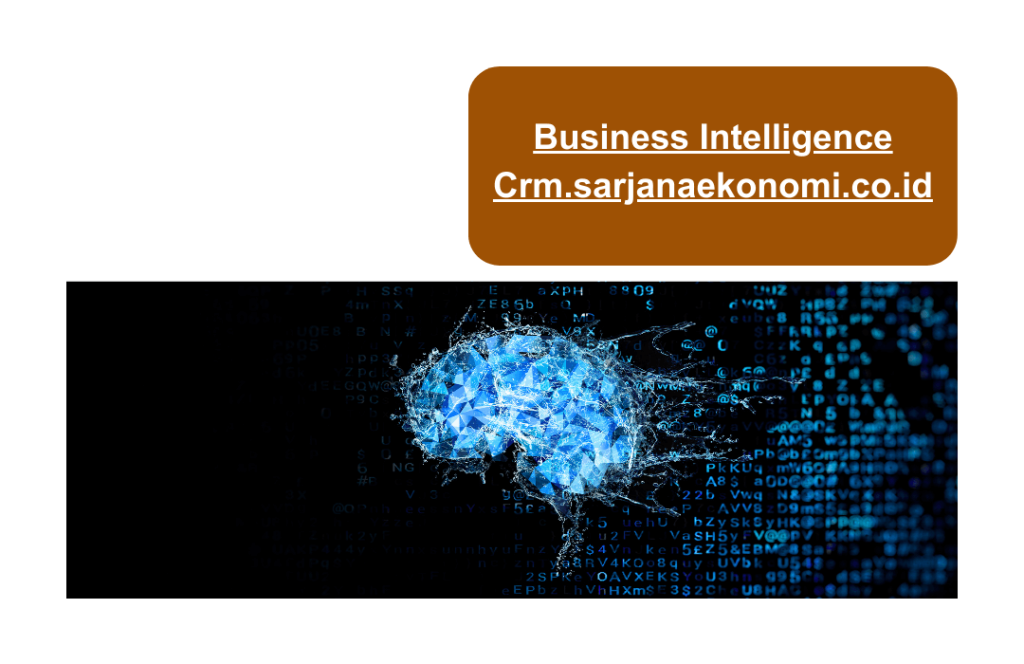Business Intelligence Crm.sarjanaekonomi.co.id: The Future of Data-Driven Decision Making

In today’s rapidly evolving business landscape, the fusion of Business Intelligence (BI) and Customer Relationship Management (CRM) is not just a trend but a necessity. This amalgamation, often referred to as Business Intelligence CRM, empowers organizations to make informed decisions, enhance customer satisfaction, and drive sustainable growth. This comprehensive article will explore the nuances of Business Intelligence Crm.sarjanaekonomi.co.id, its benefits, implementation strategies, and its future trajectory.
Understanding Business Intelligence (BI)
What is Business Intelligence?
Business Intelligence (BI) encompasses the strategies, technologies, and tools that organizations use to collect, process, and analyze data. The goal is to transform raw data into actionable insights, thereby facilitating strategic decision-making. BI systems are designed to handle vast amounts of unstructured data to help identify, develop, and create new strategic business opportunities.
Components of Business Intelligence
- Data Warehousing: Centralized repositories where data from different sources is stored, making it easier to retrieve and analyze.
- Data Mining: The process of discovering patterns and relationships in large data sets to predict future trends.
- Reporting and Querying: Tools and software that allow users to extract and analyze data from databases.
- Dashboards: Visual representations of data that provide at-a-glance views of key performance indicators (KPIs) and metrics.
- Online Analytical Processing (OLAP): A category of software tools that provide analysis of data stored in a database.
Understanding Customer Relationship Management (CRM)
What is CRM?
Customer Relationship Management (CRM) is a technology for managing all your company’s relationships and interactions with current and potential customers. The primary goal of CRM is to improve business relationships, focusing on customer retention and ultimately driving sales growth.
Components of CRM
- Contact Management: Storing and managing customer information.
- Sales Management: Streamlining the sales process and sales pipeline management.
- Customer Service: Managing customer interactions and support services.
- Marketing Automation: Automating marketing tasks and workflows to increase efficiency.
- Analytics: Analyzing customer data to make informed business decisions.
The Synergy Between BI and CRM
The integration of BI and CRM creates a powerful synergy that allows businesses to gain deeper insights into customer behaviors, preferences, and trends. This integration is essential for businesses that aim to provide personalized customer experiences and stay competitive in the market.
Benefits of Business Intelligence CRM
- Enhanced Customer Insights: By integrating BI with CRM, businesses can analyze customer data more effectively. This integration provides a 360-degree view of customers, allowing businesses to understand customer behavior, preferences, and purchasing patterns.
- Improved Decision Making: BI tools integrated with CRM provide real-time data analysis, enabling businesses to make data-driven decisions. This leads to better strategic planning and execution.
- Increased Sales and Revenue: With detailed customer insights and predictive analytics, businesses can identify sales opportunities and tailor their marketing efforts to increase conversions and revenue.
- Optimized Marketing Campaigns: BI CRM helps in segmenting customers based on various criteria, enabling personalized marketing campaigns that resonate with the target audience, leading to higher engagement and conversion rates.
- Enhanced Customer Service: By analyzing customer interaction data, businesses can identify common issues and improve their customer service processes, leading to higher customer satisfaction and loyalty.
Implementation Strategies for Business Intelligence CRM
Implementing a Business Intelligence CRM system requires careful planning and execution. Here are the key steps involved:

Step 1: Define Clear Objectives
Before implementing a BI CRM system, it’s crucial to define clear objectives. Determine what you aim to achieve with the integration, such as improving customer satisfaction, increasing sales, or optimizing marketing campaigns. Having clear objectives will guide the implementation process and ensure alignment with business goals.
Step 2: Choose the Right Tools and Technologies
Selecting the right tools and technologies is critical for the success of a BI CRM system. Evaluate different BI and CRM solutions based on your business needs, scalability, ease of use, and integration capabilities. Some popular BI tools include Tableau, Power BI, and QlikView, while Salesforce, HubSpot, and Zoho CRM are widely used CRM platforms.
Step 3: Data Integration
Integrate data from various sources, including customer databases, sales records, marketing platforms, and social media. Ensure that the data is cleansed and standardized to maintain accuracy and consistency. Data integration tools like Informatica, Talend, and Apache Nifi can help streamline this process.
Step 4: Develop a Data Warehouse
Create a centralized data warehouse where all customer data is stored. This will serve as the foundation for data analysis and reporting. Ensure that the data warehouse is scalable and secure to handle large volumes of data.
Step 5: Implement Analytics and Reporting Tools
Deploy analytics and reporting tools that allow you to visualize and analyze data. Dashboards and reports should be customizable to meet the specific needs of different departments within the organization. This will enable stakeholders to access real-time insights and make informed decisions.
Step 6: Train Employees
Ensure that employees are trained to use the BI CRM system effectively. Provide comprehensive training sessions and resources to help them understand how to navigate the system, generate reports, and interpret data insights.
Step 7: Monitor and Optimize
Continuous monitoring and optimization are essential to maximize the benefits of a BI CRM system. Regularly review the performance of the system, identify areas for improvement, and make necessary adjustments. This will ensure that the system remains aligned with business goals and continues to deliver value.
Challenges in Implementing Business Intelligence CRM
While the benefits of BI CRM are substantial, implementing such a system is not without challenges. Here are some common challenges and how to address them:
Data Quality and Integration Issues
One of the major challenges is ensuring data quality and seamless integration. Poor data quality and inconsistent data formats can lead to inaccurate insights and hinder decision-making.
Solution: Invest in data cleansing and integration tools to standardize data formats and ensure data accuracy. Establish data governance policies to maintain data quality over time.
Resistance to Change
Employees may resist adopting new technologies and processes, especially if they are accustomed to existing systems.
Solution: Provide comprehensive training and demonstrate the benefits of the new system to employees. Involve them in the implementation process to gain their buy-in and address any concerns.
Cost and Resource Constraints
Implementing a BI CRM system can be expensive and resource-intensive. Small and medium-sized businesses may find it challenging to allocate the necessary budget and resources.
Solution: Start with a phased implementation approach, focusing on high-priority areas first. Consider cloud-based solutions that offer scalability and cost-effectiveness.
Data Security and Privacy
With the increasing focus on data privacy regulations, ensuring the security and privacy of customer data is paramount.
Solution: Implement robust security measures, such as encryption, access controls, and regular security audits. Ensure compliance with data privacy regulations like GDPR and CCPA.
The Future of Business Intelligence CRM
The future of Business Intelligence CRM is promising, with several trends shaping its evolution. Here are some key trends to watch:
Artificial Intelligence and Machine Learning
The integration of Artificial Intelligence (AI) and Machine Learning (ML) with BI CRM systems will revolutionize how businesses analyze data and make decisions. AI and ML can automate data analysis, identify patterns, and provide predictive insights, enabling businesses to stay ahead of the competition.
Predictive Analytics
Predictive analytics will become more prevalent in BI CRM systems. By analyzing historical data, businesses can predict future trends and customer behaviors, allowing them to proactively address customer needs and optimize their strategies.
Customer Experience Management
Customer Experience Management (CEM) will be a focal point for businesses. BI CRM systems will evolve to provide more personalized and seamless customer experiences across all touchpoints, enhancing customer satisfaction and loyalty.
Integration with IoT
The Internet of Things (IoT) will generate vast amounts of data from connected devices. Integrating IoT data with BI CRM systems will provide businesses with deeper insights into customer behaviors and preferences, enabling more targeted and effective marketing strategies.
Real-time Data Analysis
Real-time data analysis will become the norm, allowing businesses to make instant decisions based on up-to-date information. This will enhance agility and responsiveness in a fast-paced business environment.
Case Studies: Successful Implementation of Business Intelligence CRM
Case Study 1: Amazon
Amazon is a prime example of a company that has successfully implemented BI CRM. By leveraging advanced analytics and machine learning algorithms, Amazon analyzes customer data to provide personalized product recommendations, optimize inventory management, and enhance customer service. This has resulted in increased customer satisfaction and loyalty, driving significant revenue growth.
Case Study 2: Starbucks
Starbucks uses BI CRM to analyze customer data and tailor marketing campaigns. Through their loyalty program, Starbucks collects data on customer preferences and purchasing patterns. This data is used to send personalized offers and promotions, leading to higher customer engagement and increased sales.
Case Study 3: Netflix
Netflix relies heavily on BI CRM to understand customer preferences and deliver personalized content recommendations. By analyzing viewing patterns and user behavior, Netflix ensures that customers receive relevant content suggestions, enhancing their viewing experience and retaining subscribers.
Conclusion
Business Intelligence Crm.sarjanaekonomi.co.id is a powerful combination that enables businesses to leverage data for informed decision-making, improved customer experiences, and sustainable growth. By integrating BI and CRM, businesses can gain deeper insights into customer behaviors, optimize their strategies, and stay competitive in the market.
Implementing a BI CRM system requires careful planning, the right tools and technologies, and a commitment to continuous optimization. While there are challenges, the benefits far outweigh the costs, making BI CRM an essential investment for businesses of all sizes.
As technology continues to evolve, the future of BI CRM holds exciting possibilities, from AI-driven insights to real-time data analysis. Businesses that embrace these trends will be well-positioned to thrive in the data-driven world of tomorrow.

